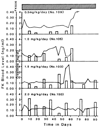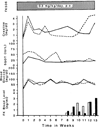Immunosuppression of canine, monkey, and baboon allografts by FK 506: with special reference to synergism with other drugs and to tolerance induction
- PMID: 2456627
- PMCID: PMC2972580
Immunosuppression of canine, monkey, and baboon allografts by FK 506: with special reference to synergism with other drugs and to tolerance induction
Abstract
In dogs the most effective oral dose of FK 506 for prevention of renal homograft rejection was 1.5 mg/kg/day. With maximum credit allowed at 90 days, survival was increased to 61.0 +/- 33.6 (SD) days compared with 13.0 +/- 4.1 in untreated control animals. Higher doses were toxic. The smallest dose that was used (0.5 mg/kg/day) prolonged survival after renal transplantation to 33.7 +/- 23.9 (SD) days. When the small dose of FK 506 was combined with 5 mg/kg/day of cyclosporine and 5 mg of prednisone, five of six canine kidney recipients lived for 90 days. These results were degraded by omission of any of the constituent drugs or reduction by half of the triple drug doses. Thirteen of the dogs treated with various drug regimens lived for 90 days, after which time treatment was stopped; 10 of the dogs eventually rejected the grafts, but three had continued graft function for 6 months or longer and may be permanently tolerant. Moreover, in dogs when 1 mg/kg of intramuscular FK was given to 19 kidney and seven liver recipients for 3 days on postoperative days 1 to 3, 4 to 6, or 7 to 9, the animals survived subsequently for 11 to more than 160 days. All but four of the grafts were eventually rejected, but the prolonged effect of a short course of delayed therapy suggests the possibility of tolerance induction. In cynomolgus monkeys and baboons, FK as a single drug was found to be immunosuppressive after kidney transplantation. Correlation in the dogs and primates between immunosuppression, toxicity, and FK blood levels was not possible because of presently imperfect standardization of assay and monitoring techniques. FK had serious side effects in dogs, but not so obviously in monkeys and not at all in baboons.
Figures




References
-
- Goto T, Kino T, Hatanaka H, et al. Discovery of FK-506, a novel immunosuppressant isolated from Streptomyces tsukubaensis. Transplant Proc. 1987;19 suppl 6:4–8. - PubMed
-
- Kino T, Hatanaka H, Hashimoto M, et al. FK-506, a novel immunosuppressant isolated from a streptomyces. I. Fermentation, isolation, and physico-chemical and biological characteristics. J Antibiotics. 1987;40:1249–1255. - PubMed
-
- Kino T, Hatanaka H, Miyata S, et al. FK-506, a novel immunosuppressant isolated from a streptomyces. II. Immunosuppressive effect of FK-506 in vitro. J Antibiotics. 1987;40:1256–1265. - PubMed
-
- Ochiai T, Nakajima K, Nagata M, et al. Effect of a new immunosuppressive agent, FK 506, on heterotopic cardiac allotransplantation in the rat. Transplant Proc. 1987;19:1284–1286. - PubMed
-
- Ochiai T, Nagata M, Nakajima K, et al. Studies of the effects of FK 506 on renal allografting in the beagle dog. Transplantation. 1987;44:729–733. - PubMed
Publication types
MeSH terms
Substances
Grants and funding
LinkOut - more resources
Full Text Sources
Other Literature Sources
Medical
